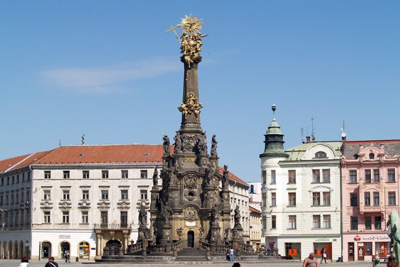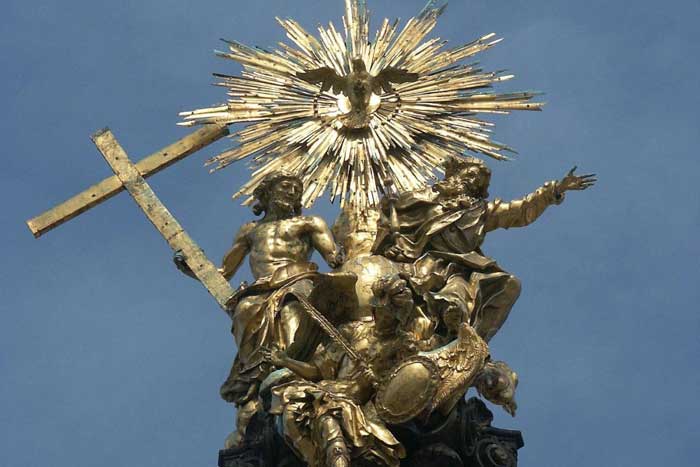
The Baroque is an excessively decorated extravagant style of architecture, that flourished in the late 16th-century Italy. Built between 1716 and 1754, the Holy Trinity Column in Olomouc is a Baroque monument in the Czech Republic. Basically, it was constructed for the purpose of a spectacular celebration of the Catholic Church and faith, partly stemming by the feeling of gratitude for the ultimate end of a disastrous and deadly plague, which attacked and damaged Moravia (now in Czech Republic) between 1714 and 1716. As all the artists and master craftsmen working on this monument were the citizens of Olomouc, the Holy Trinity Column also symbolized a natural expression local patriotism.
Strangely enough, the column has witnessed the death of many persons, who were deeply involved in its creation. The first man to die was Wenzel Render, a monumental mason and a privileged imperial architect. He was the man, who came with the idea to build the column. He enforced his vision upon the city council, designed it, built the first stage and even helped to finance it. Unfortunately, he died within a short time after the beginning of the work. After his death, none of his followers - Franz Thoneck, Johann Wenzel Rokický and Augustin Scholtz - did survive long enough to see the completion of the column. However, despite the strange consecutive sad demises of the four master craftsmen, a fifth man, Johann Ignaz Rokický accepted the challenge and finally completed the divinely-inspired monument.
But, that was not the end of the story and more deaths followed. The sculptural decoration of the column was started by Phillip Sattler and after his death, Andreas Zahner took the charge. He completed 18 sculptures and 9 reliefs in seven years before he died as well.


Goldsmith Simon Forstner created the gilded copper sculptures of the Holy Trinity along with the Archangel Gabriel and the Assumption of the Virgin, which crowned the column. He was somewhat luckier and managed to finish his brilliant work during his lifetime. Unfortunately, he became irrecoverably ill and lost his life due to over exposure of the toxic mercury compounds during the gilding process of the sculptures.
The Holy Trinity Column in Olomouc, built in the characteristic regional style known as the Olomouc Baroque, is without equal in any other town, due to its monumental dimensions, the richness of its sculptural decoration, and the overall artistic skill and execution. The nearly 115 feet tall column is crowned with a magnificent gilded copper sculpture of the Holy Trinity (consisting of God, Jesus and the Holy Spirit in the form of a flying dove),accompanied by the Archangel Gabriel above and the Assumption of the Virgin beneath.


The three tiered base of the column is surrounded by 18 stone sculptures of saints and 14 reliefs in an elaborate ornamental frame, known as ‘cartouches’. The topmost tier is decorated with the sculptures of saints connected with Jesus’ life on earth - his mother’s parents, his father St. Joseph (John 1:45) and St. John the Baptist, along with St. Lawrence and St, Jerome, the saints to whom the chapel in the Olomouc town hall was dedicated. Three reliefs represent Faith, Hope and Love - the ‘Three theological virtues’. The second tier is dedicated to Moravian saints, which include among others, St. Cyril and St. Blaise, in whose name one of the main Olomouc churches was consecrated. It also includes the statue of John Sarkander, a priest who was tortured to death in Olomouc prison in the beginning of the Thirty Years’ War as he refused to break the seal of confession. He was canonized subsequently in 1995.The lowest tier is decorated with the saints who were connected to Olomouc, even if they were not from here – an Austrian saint, St Florian, viewed as a protector against various disasters, especially fire, an Austrian patron St. Maurice, a Bohemian patron St. Wenceslas, St Aloysius Gonzaga who was a patron of students and others.
The base of the column also houses a small chapel, with reliefs, which include Noah’s first burnt offering after the Flood, Abraham’s offering of Isaac along with a lamb and death of Jesus. The incorporation of a complete chapel in the body of the column, made the Holy Trinity Column quite exceptional.


The construction of the Holy Trinity Column started in 1716 but wasn’t finished until 1754, which means it took long 38 years to finish a single column. After the end of the long and lingering process of construction, it became a source of great pride and pleasure for Olomouc, since all people participating in its creation were citizens of the town. The column was consecrated in a great jubilation in the presence of Empress Maris Theresa and her husband Francis.
Four years after the ceremonial inauguration of the Holy Trinity Column in 1754, Frederick the Great of Prussia invaded Moravia in the beginning of May 1758 and besieged the fortified city of Olomouc. During the course of war, the column was hit by the enemy cannons several times. However, soon after the end of the war, the column was repaired. A reproduction of a gilded stone shot was half-buried in the stem of the column on the spot where it was hit to remind people that the column was once hit by the Prussian cannons.

With its great dimensions and richness of artistic decorations, the Holy Trinity Column, located at the heart of the historic centre of the town of Olomouc in Central Moravia, is recognized as the biggest Baroque sculptural group in the Czech Republic. In 2000 it was added to Unesco's World Heritage Site list. The Holy Trinity Column is owned and managed by the City of Olomouc and it provides for the maintenance and protection of the property.
